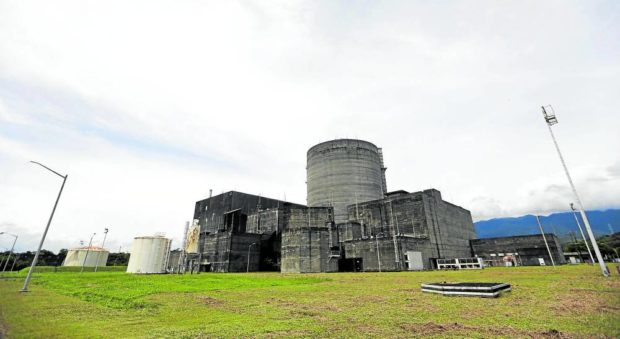Duterte: Include nuclear power in PH energy mix

BATAAN NUCLEAR PLANT A testament to corruption during the Marcos era. —INQUIRER FILE PHOTO
MANILA, Philippines — President Rodrigo Duterte has signed an executive order to include nuclear power in the country’s energy mix and look into the reopening of the mothballed Bataan Nuclear Power Plant (BNPP).
Executive Order No. 164, signed last February. 28 and made public on Thursday, was issued following the recommendation of the Nuclear Energy Program Inter-Agency Committee, which was created in July 2020 to conduct a pre-feasibility study and public consultation on the issue.
Through EO 164, the government said it recognized that nuclear power could be a reliable, cost-competitive, and environment-friendly source of energy based on the experience of highly developed countries.
“For the country to achieve its sustained growth targets, it must ensure that it has a reliable, secure, sustainable, quality and affordable electricity supply, including sufficient reserve to guarantee that there will be no disruptions in the power supply,” the EO read.
It added that the use of nuclear energy would address the increasing demand for clean energy, which was seen rising by 4.4 percent annually, or an additional capacity of 68 gigawatts by 2040.
‘Great legacies’
While acknowledging that nuclear energy could be “potentially dangerous,” Director Carlo Arcilla of the Philippine Nuclear Research Institute assured the public that the government would follow international guidelines, standards—particularly by the International Energy Agency—in handling nuclear energy.
He said the EO “will be one of the great legacies” of Duterte, whose term ends in June.
READ: Bataan nuclear plant safe to revive – PNRI
Advocates claim nuclear is a clean energy source as it generates power through fission, or the process of splitting uranium atoms to produce energy, which is then used to create steam to turn a turbine to generate electricity without the harmful byproducts emitted by fossil fuels such as coal and oil.
In a briefing on Thursday, Department of Energy (DOE) Assistant Secretary Gerardo Erguiza pointed out that new technologies have made nuclear a safer source of energy.
He pointed out, however, that a new regulatory framework must be crafted to make investments in nuclear power more feasible and attractive to both the government and the private sector.
He added that even with a new framework, the earliest possible use of nuclear in the country might not be until 2027.
Embracing other energy sources is crucial as the Philippines moves to phase out coal-fired power plants as part of its global climate goal commitments.
It can also help address seasonal power outages and high electricity prices, but nuclear is expected to meet stiff opposition from environmentalists.
Against global trend
Roland Simbulan, former chair of the Nuclear Free Philippines Coalition, which led the fight leading to the mothballing of BNPP in 1986, on Thursday opposed EO 164 due to “public health and safety” concerns.
He said in a phone interview that Duterte’s order went against global trends.
READ: How battle vs Bataan nuke plant was won
“Germany, the largest EU country, completes phasing out all its nuclear power plants this year, a phasing out started 10 years ago after the Fukushima nuclear disaster. Taiwan’s ‘nuclear-free homeland 2025’ targets closing down all three nuclear power plants by 2025,” Simbulan said.
He added: “Vietnam, Thailand, and Indonesia have disbanded their nuclear plans. Nations have embarked on renewable energy options which are now proven more economically cheaper, safer and cleaner after consulting vital stakeholders from communities.”
He said taking legal action against the Duterte order was “an option in the future.”
In a statement on Thursday, Greenpeace campaigner Khevin Yu also urged the Duterte administration to revoke EO 164.
“We believe it is a treacherous move spurred by misguided interests that are not aligned with the interests of the Filipino people. Nuclear is the most dangerous and most expensive source of electricity,” he said.
“The Duterte administration is about to leave a tarred legacy and is setting us up for another horror story like Chernobyl and Fukushima (the two worst nuclear disasters in the world),” Yu added.
Corruption, safety issues
The Institute for Climate and Sustainable Cities (ICSC) added that tapping nuclear energy was “inconsistent with the aims of DOE to modernize the power sector.”
“We need to take modernization of the power sector far more seriously, and that begins with a power sector that relies more and more on flexible and distributed generation. The Philippines has an abundance of variable reliable power in the form of wind, solar, biomass, geothermal and hydro resources that remain untapped—including the irreversible rise of storage options,” said Renato Redentor Constantino, executive director of ICSC.
The BNPP was the only nuclear power plant in the region during the 1980s as the Philippines was one of the first in Southeast Asia to embark on a nuclear energy program.
However, the project was mothballed because of corruption allegations and safety concerns on the use of nuclear energy after the deadly Chernobyl disaster in April 1986.
A study conducted by Russia State Atomic Energy Corp. in 2017 said the rehabilitation of BNPP would require around $3 billion to $4 billion.
The BNPP sits on a 357-hectare government reservation at Napot Point in Morong, Bataan.
It was built for nine years beginning 1975 at a cost of $2.3 billion, bloated from the initial estimate of only $600 million allegedly due to payoffs to some government officials.
Ferdinand Marcos’ successor, Corazon Aquino, shelved the project indefinitely in 1986, but the country continued to pay for the foreign loans that funded the power plant. —With reports from Karl R. Ocampo, Reuters AND Inquirer Research
RELATED STORIES
Bishop: Bataan residents oppose nuclear plant
Isko Moreno not keen on reviving Bataan nuclear power plant
Bongbong Marcos to revisit Bataan nuclear power plant, OPSF — adviser